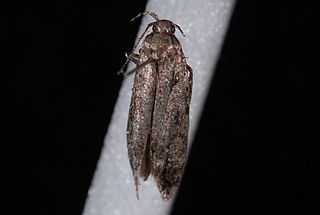
Neotelphusa is a genus of moths in the family Gelechiidae.
Coleophora traugotti is a moth of the family Coleophoridae. It is found in Spain.

Neotelphusa sequax is a moth of the family Gelechiidae. It is found in most of Europe and has also been recorded from North America.
Neotelphusa anisogrisea is a moth of the family Gelechiidae. It is found in Namibia and South Africa.
Neotelphusa bimaculata is a moth of the family Gelechiidae. It is found in Namibia.
Neotelphusa cirrhomacula is a moth of the family Gelechiidae. It is found in South Africa.
Neotelphusa flavinotata is a moth of the family Gelechiidae. It is found in South Africa.
Neotelphusa tapinota is a moth of the family Gelechiidae. It is found in South Africa.
Neotelphusa pallidistola is a moth of the family Gelechiidae. It is found in South Africa.
Neotelphusa obliquifascia is a moth of the family Gelechiidae. It is found in Mozambique.
Neotelphusa querciella is a moth of the family Gelechiidae. It is found in North America, where it has been recorded from Alabama, Kentucky, Maine, Mississippi, North Carolina and Tennessee. The larvae feed on Quercus obtusiloba.
Neotelphusa castrigera is a moth of the family Gelechiidae first described by Edward Meyrick in 1913. It is found in South Africa and Zimbabwe.
Neotelphusa craterota is a moth of the family Gelechiidae first described by Edward Meyrick in 1913. It is found in South Africa.
Neotelphusa cisti is a moth of the family Gelechiidae. It is found on the Canary Islands and in North Africa, Turkey, Corsica, Sardinia, Cyprus, France, Croatia, Italy, Bulgaria, Greece and Portugal.
Neotelphusa huemeri is a moth of the family Gelechiidae. It is found in Portugal, Spain, southern France and on Corsica and Sardinia.
Neotelphusa limenaea is a moth of the family Gelechiidae. It is found in South Africa.
Neotelphusa melicentra is a moth of the family Gelechiidae first described by Edward Meyrick in 1921. It is found in Mozambique.
Neotelphusa ochlerodes is a moth of the family Gelechiidae. It is found in Namibia.
Neotelphusa ochrophthalma is a moth of the family Gelechiidae. It is found in South Africa and Namibia.

Neotelphusa praefixa is a moth of the family Gelechiidae. It is found in North America, where it has been recorded in Alberta, British Columbia, Maine, Manitoba, Montana, Ontario, Quebec and Saskatchewan.

